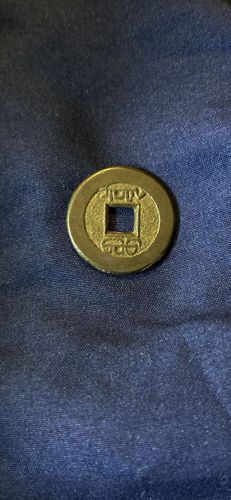Chinese Cash Coin (e.g., Kai Yuan Tong Bao, Song Dynasty Cash Coin, Qing Dynasty Cash Coin, etc. - specific name depends on characters)
Country of Origin: China
Year of Issue: Uncertain from the image alone, but likely dates from a period between the Tang Dynasty (618-907 AD) and the Qing Dynasty (1644-1912 AD), as this style was common throughout these periods.
Denomination: 1 Cash (Wen)
Composition: Bronze or Brass (typical for most Chinese cash coins)

Brief Description
The coin is round with a square hole in the center, a common feature of ancient Chinese coinage. It appears to be made of a bronze or brass alloy. The characters on the coin are in Chinese script, typical of cash coins. Given the image, it's difficult to discern the exact characters (which would identify the emperor or reign period), but they are arranged around the central square.
Historical Significance
Chinese cash coins like this have a rich history, dating back over two millennia. They were the primary form of currency in China for a very long period, from the Qin Dynasty right up to the early 20th century. Their design, with the square hole, was symbolic: the round represents heaven and the square represents earth. They were crucial to China's economic and administrative systems. The characters generally denote the reign title of the emperor or the name of the mint, providing historical context for the specific period of issue. They facilitated trade within China and along the Silk Road, playing a vital role in the development of Chinese society and economy.
Estimated Value
Varies significantly depending on the specific reign period, rarity, condition, and actual characters. Common types can range from a few USD ( A coin from the Song Dynasty, for example, could be anywhere from $1 to $50, with rarer variants being much more valuable.) to hundreds or even thousands for rare varieties or exceptional condition.
Care Instructions
Handle the coin by its edges to prevent transferring oils from your skin. Store in a cool, dry place, ideally in an inert, non-PVC holder or slab. Avoid cleaning as this can damage the patina and significantly reduce its value. If cleaning is absolutely necessary for identification or preservation, consult a professional conservator.
Created At: 2025-08-05T19:01:32.816485